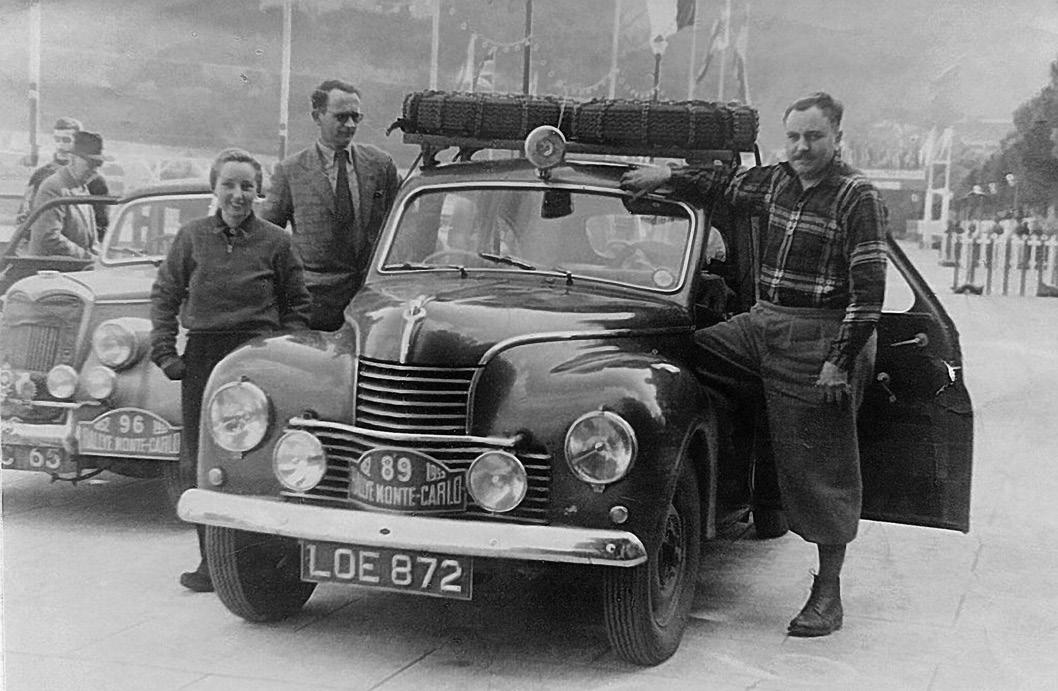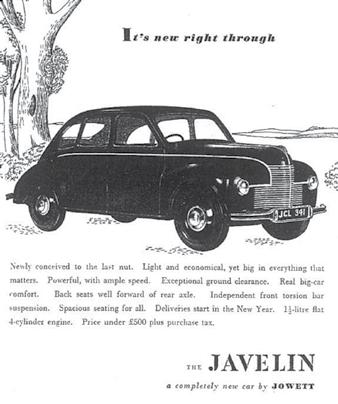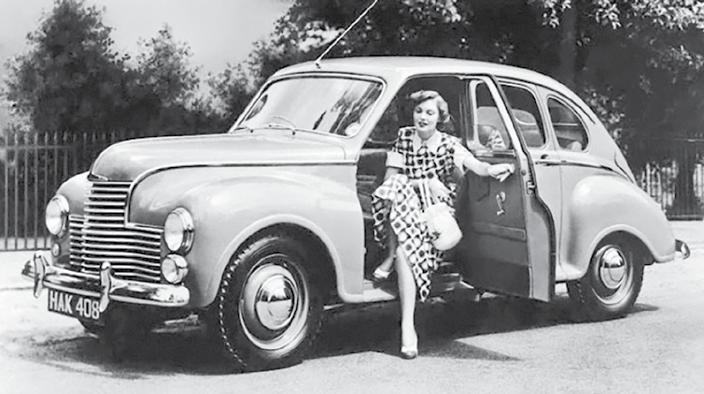
7 minute read
What They Said … 1945 Jowett Javelin
WHAT THEY SAID ABOUT THE
XXII Rallye De Monte Carlos 1952 Arrivee a Monaco.
1945–54 JOWETT JAVELIN
WORDS AND PHOTOS GRAEME RICE
It can be helpful, and sometimes amusing, to look back to see what the motoring press had to say about new vehicles at the time of their release to the public. Graeme Rice takes us back in this retrospective journey.
There’s something rather poignant about a company which, for over 35 years, produced a succession of steady, economical and reliable cars, well suited to their hilly Yorkshire landscape, that under new ownership launches a race winning, high performance six-seater with an advanced specification intended for export markets.
In late 1942, with both Jowett brothers dead, new managing director Calcott Reilly was aiming high, preparing for the post-war motoring boom and hunting for a bright young chief engineer who could help Jowett achieve their share of that.
Initially reluctant to make the move, 30 year-old Gerald Palmer was enticed north on a salary of £500 with the brief to design a new breed of Jowett. In fact, a new breed of high performance saloon.
Interest in the new car was intense, with The Motor of August 1944 scooping the story that the new Jowett was already being road tested.
This was followed up in September 1945 when Autocar reported;
“Jowett have been allowed to make an experimental prototype which incorporates a number of interesting new features. It will continue the Jowett reputation for roominess, but to this characteristic has been added up-to-date speed, streamlining and springing.”
If this aroused high expectations, then Jowett’s announcement of May 1946 really set tongues wagging;
“Jowett’s Chairman has announced a new design of car – the Javelin. Described as a streamlined, generously proportioned six-seater in which fine acceleration and performance have been achieved with careful use of light alloy materials which give a very favourable power to weight ratio.”
William Boddy, Editor of Motor Sport magazine, reported in the November 1946 issue;
“The Jowett previously has never been a high-performance automobile, but the new “Javelin” appears to be in this category. The old-established Bradford concern has had the happy idea of putting a 1,485cc version of its flat-four engine into a new chassis with 8 ft. 6 in. wheelbase, torsion bar i.f.s. damped by hydraulic telescopic shock-absorbers, an 8½-in. ground clearance, and with integral pressed-steel Briggs Motor Bodies saloon coachwork. The Jowett “Javelin” weighs 18 cwt. Dry, does 50 in 3rd, and goes along effortlessly at about 70 mph in top gear. This is unquestionably one of Britain’s more promising small saloons.”
Eight months later, Bill Boddy was able to test a Javelin and was no less enthused about the new model;
“The Jowett Javelin is an astonishing car and a credit to the British technician. At last we have a saloon car which can hold up its head when it encounters the Continentals. Realise that this very brisk newcomer is of a mere 1,500cc, has ample room within for six persons, and is no more different in appearance than the more


modest pre-war American cars, and you will, as we do, enthuse over this refreshing newcomer from Bradford. Conducting our usual tests we got highly commendable results. There was a moderate wind and the surface was dry. The flying 1/4 mile was covered at 72.6 mph downwind, and the mean of the best two runs, one in each direction, was 70.42 mph. The car was still accelerating somewhat at the end of the run and we would put its absolute maximum at 75 to 77 mph. The speedometer showed 80 m.p.h. on one occasion. The best standing 1/4 mile occupied 22.6 sec. and the best 0-50 m.p.h. 14.6 sec.
These figures well portray the liveliness of the Javelin, as reflected in the excellent averages of which the car is capable. It ranks as one of the really fast A. to B. motorcars with extreme ease and safety. “
Boddy concluded his test by suggesting the Javelin was an ideal car for a sporting motorist who needed a sporting car that was both weatherproof and thief-proof, or one who had an Alfa Romeo 2.8 which needed a sporting companion for everyday use.
And a sporting car the Javelin was proving to be, with class wins in the Monte-Carlo Rally and Spa 24 Hours.
Motor Sport in March 1949 reported; “Of the class winners, every praise should be bestowed on T. C. Wise’s Jowett Javelin saloon, from Glasgow, which, heavily-laden, got through to win the 1½litre class by 11.8 marks from Gatsonides’ 1949 Hillman Minx saloon, and another Jowett Javelin, handled by R. Smith. Thus Jowett’s faith in “horizontal opposition” and torsional suspension is justified and the reputation of these popular modern 1½ litre cars is materially enhanced.”
TC Wise also expressed surprise at the Javelin’s ability to cruise at 70mph and climb and descend the mountain passes at average speeds of 45 – 50mph.
In their August 1949 edition Motor Sport were once again able to wax lyrical about the Javelin’s performance in the Spa 24 Hours where the Javelin won its class, averaging the sort of speed that would leave most 1949 1½ litre cars gasping for breath.
A normally straight faced Motor Sport reporter struggled to contain his pride that a product of the humble little Yorkshirebased firm should unexpectedly not only win the 2 litre touring car class, but do so “splendidly.”
“But perhaps the Jowett Javelin saloon driven by Hume and Wisdom put up the best show of all, at the 24 Hours of Spa, for it covered a greater distance than any other 1 ½-litre car in winning the touring-car category. It was a virtually standard car, greatly hampered by wide gear ratios, but with slightly increased compression-ratio, careful assembly of the flat-four engine and reduction of weight by leaving out some of the interior furnishings. It averaged over 65 mph for 1,573.92 miles, beating the fastest H.R.G. by 10 miles.” “Wisdom and Hume,” they wrote, “had a normal Jowett Javelin saloon a lap ahead of a BMW, and two laps ahead of an MG, in the 2-litre touring class, the Jowett having averaged over 67 mph, defeating, also, Citroen and Lancia cars.”
They summed up their report saying, “Britain can be justifiably very proud of its Aston-Martins, which were third, fourth and fifth and of the Jowett Javelin saloon which, in its first race, won the 2-litre touring class, covering 114 more miles than its nearest rival, an MG.”
The Motor 1949 road test of the four-cylinder 1486cc, 50bhp, four speed, column change Javelin hints at the dilemma faced by road testers unused to having to slot such an all-round capable car into one convenient pigeon hole, reminding readers that;
“This year the Javelin gained public recognition in the competition world by winning the 1½ litre category in the Monte Carlo Rally and more recently the fastest touring car category in the Spa 24 Hour race.” “After a 2000 mile road test of this new 1½ litre car priced at £928 incl PT, offering outstanding performance, economy and comfort on rough roads we have, a car capable of exceeding 75mph, able to accelerate from 0 – 30mph in 6.2 secs; 0 – 50mph 15.3secs; 0 – 60mph 22.2 secs and which still covers 100 miles on between three and four gallons of petrol depending on the average speed required. It also offers a commendably large space with armchair comfort for four and possibly six. Such a combination of features is hard to find in the motoring world.” Similar sentiments were expressed by the 1952 Motor road test of the £1261 De Luxe Javelin with the 52.5bhp engine, closer gear ratios and woodgrain dashboard.
“In writing of the Jowett Javelin De Luxe one is immediately faced with a problem. Should one regard it as a 1½-litre sports saloon possessed of unusual roominess and comfort with a very modest 27mpg appetite for fuel? Or should it be treated as a 1½-litre touring car in which quite unusual performance has been obtained with no sacrifice of economy?”
“Only one other make of saloon tested by us since the war has bettered the Javelin’s maximum speed and none has equalled its 0 to 50mph figure for acceleration through the gears. It’s nearest rival in these key figures was neither so economical nor as roomy.”
Sadly, by 1954, and after 23,000 Javelins had been made, it was all over. In their book The Complete Jowett History, Paul Clark and Edmund Nankivell acknowledge the well-known issues of gearbox failures and crankshaft web breakages that contributed to Jowett’s downfall. They also noted that the survival of many specialist car makers like Riley, Sunbeam, Triumph and Talbot depended for survival on merging with bigger companies. Jowett would have struggled to survive alone.







